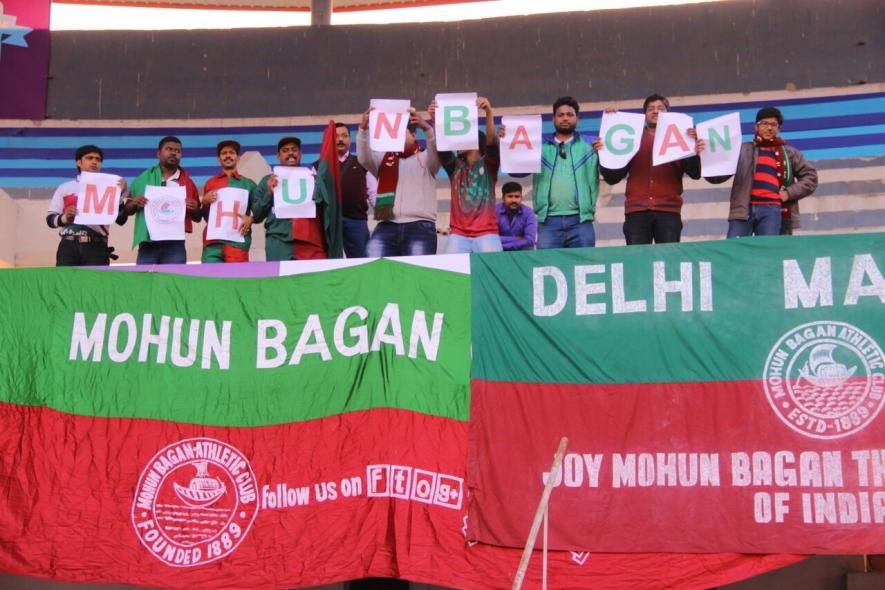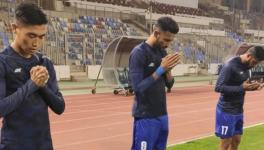Why I League is the Real Deal for Indian Football

The Hero I-League kicked off this week with games that were held as far and wide as Goa, Ludhiana and Kolkata. After months of debate, speculation, ranting and raving, it was finally time to shift the focus to the 10 clubs that will compete—over the next three months or so—for the title of champions of India. We have already seen the two biggest clubs in the competition—Kolkata’s East Bengal and Mohun Bagan—as well as defending champions Aizawl FC in action.
Minerva Punjab Hold Mohun Bagan
Bagan kicked things off at home to Minerva Punjab in Ludhiana. The setting was perfect. A cold, foggy winter evening at the Guru Nanak Stadium provided the gritty setting. The pitch was patchy, unlike the immaculate turfs we have gotten used to on TV and with major tournaments such as the FIFA under-17 World Cup.
As the squads lined up for kickoff, one couldn't help but be excited at the prospect of an endless series of hard-fought, scrappy games. Unsurprisingly, it was Sony Norde who broke the deadlock with a sublime bit of individual play. Intercepting just inside the oppossition half, the Haitian striker bombed up the right flank with only the goal in mind. The ease with which he rounded Minerva’s Ivorian defender Guy Eric Dano, and the composed finish into the bottom left corner, was testament to Norde’s ability. At this level he will be a constant presence on the scoresheet.
Bagan have done exceptionally well to hold on to the Haitian even though he could as easily have been playing in the more lucrative Indian Super League. But if the Mariners thought the goal, just before half time, would put an end to Minerva’s will to defend, they had another thing coming.
In fact, it was the young Punjabi club that had the better of the chances in the game. Deepak Devrani skied a sitter from inside the box and Lago Dagbo Bei hit the upright. The game ended in dramatic fashion. Minerva academy product Moinuddin Khan, 20, scored a scrappy equaliser in the final minute to give the home team a well-deserved point on the day.
Minerva are one of several teams in the I League that are focussed on developing a pipeline for young players that culminates with playing for the senior squad in national competitions. Moinuddin’s goal and the presence of several Punjab players in the side—the likes of captain Sukhdev Singh and keeper Arshdeep Singh—bode well for the club. It also firmly establishes the position of the I-League as the ideal platform for young Indian footballers to get experience playing highly competitive games against players of varying quality.
Aizawl Steal a Point from East Bengal
It’s a theme that was repeated over the course of the week. East Bengal are the club that have benefitted most from Aizawl FC’s title win last season. Not only did the Kolkata club manage to lure away Aizawl’s head coach—Khalid Jamil—but he also brought with him key players such as midfielders Brandon Vanlalremdika and Laldanmawia Ralte and defender Lalramchullova.
Jamie also has squad at his disposal that is replete with experienced Indian players. When the Red and Gold went two goals up—with less than 20 minutes left to play—it seemed Aizawl’s attempts at rebuilding after the mass exodus had come to nought. Paulo Meneses stuck to his plan, though, and kept faith in his players. The predominantly Mizo squad is, once again, showing just how much talent that state has to offer.
William Lalnunfela—who was part of Mizoram’s historic Santosh Trophy win that signalled the arrival of the state on the Indian football scene in 2014—grabbed two goals for the champions. The second came in the sixth minute of added time at the end of the second half and gave the People’s Club a valuable point in Kolkata.
But it was Luis Norton de Matos’ Indian Arrows that best demonstrated why the I-League is so much fun to watch. And why it here that the future of Indian football lies. Matos wanted to build a more comprehensive squad for the competition—including players from the India under-19 squad who he feels will not get enough, if any, playing time in the ISL. He did not get what he wanted and so will have to make do with the players who he worked with since taking over as coach of the under-17 team for the World Cup.
The only new face in Matos’ lineup was the 1999-born Edmund Lalrindika. One of the brightest talents in the country, Lalrindika missed out on the World Cup squad by a few months. What he adds to the Arrows in terms of a credible goalscoring threat is invaluable. Playing their first home game at the Goa Medical College ground because no turf was available in Delhi, the Arrows took to the I League like fish to water.
Compared to the CCFC, who themselves present a great platform for players from Tamil Nadu to compete at the national level, they were more energetic, better organised, more confident and far more desirous of getting the result to go their way. The Arrows are the only team in the I League without any foreign players and the oldest member of their squad is just about 18.
CCFC, on the other hand, fielded experienced players such as ex-Kyrgyzstan international Veniamin Shumeyko, Michael Soosairaj, Dhamaraj Ravanan and French forward Jean Joachim. The 3—0 win for the Arrows was a just representation of their complete domination over proceedings. It is true that Chennai could have had a couple of goals. Joachim, in particular, had a couple of pretty straightforward chances. However, Lalrindika, at the other end, could just as easily have made it five for the home side.
That the Arrows emerge from the opening round of fixtures as the most balanced and fluid side is an extraordinary achievement for Matos and his boys. Yes, they have had much better preparation than some of the other teams in the league and the relative comfort that the AIFF’s wallet and freedom from relegation afford. And the boys have been together for a long time now. But none of that should, at least not automatically, result in a junior team being able to trounce a fully professional squad. How they do over the next couple of moths will be extremely interesting to watch.
I-League > ISL…And Why
What the opening games of the 2017-18 season showed us is that it is at the I-League stage that the true following and future of Indian football will be built. The opening round of matches was the perfect advertisement for lower-league football. The categorisation of the I-League as “lower-league football” is not meant to be offensive to the clubs, players and coaches involved.
Year on year the standard of football has been on the upswing. But, when you consider this as a TV product that is competing with every international league in the world, what other categorisation can you possibly make? The ISL is also lower-league football, but with a whole bunch of pretentiousness. The difference between the two is simple. The former is played between real clubs, with real members, real fans and real histories. The latter, with the exception of Bengaluru FC (and perhaps Jamshedpur in years to come), is an IPL knock-off played between corporate franchises given out to the highest bidder.
The second point is that lower league football, all over the world, is often a lot more fun than the top flight. The atmosphere at these games is more relaxed, there is less tamasha and hype and the clubs with good support are generally those that engage with their local communities actively. Having watched games at all I-League venues, with the exception of Coimbatore, this correspondent firmly believes that an evening spent at any of them will not be a disappointment. For the clubs, this season’s I-League presents a final opportunity to establish a firm connection with a fanbase. Their future depends on it.
The prospect is mouth-watering. Three months of scrappy, down and dirty football—away from the superimposed drama and constant scrutiny that the ISL is built on—gives football fans in India an opportunity to connect, at a real level, with what is happening in our sport. The relative absence of the multiple layers of PR and marketing is what makes lower league football an attractive prospect for the fans. It gives us a chance to engage with and build our understanding of the sport, the clubs and most importantly, the players. Add to that the prospect of good goals, plenty of upsets and close finishes and you have the makings of superbly engaging season of football. Coming up this Sunday--East Bengal vs Mohun Bagan—one of the most passionately contested derbies in the world. Time to get hooked.
Get the latest reports & analysis with people's perspective on Protests, movements & deep analytical videos, discussions of the current affairs in your Telegram app. Subscribe to NewsClick's Telegram channel & get Real-Time updates on stories, as they get published on our website.
























